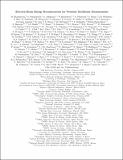Electron-beam energy reconstruction for neutrino oscillation measurements
Author(s)
Hen, Or
DownloadAccepted version (1.423Mb)
Open Access Policy
Open Access Policy
Creative Commons Attribution-Noncommercial-Share Alike
Terms of use
Metadata
Show full item recordAbstract
Neutrinos exist in one of three types or 'flavours'-electron, muon and tau neutrinos-and oscillate from one flavour to another when propagating through space. This phenomena is one of the few that cannot be described using the standard model of particle physics (reviewed in ref. 1), and so its experimental study can provide new insight into the nature of our Universe (reviewed in ref. 2). Neutrinos oscillate as a function of their propagation distance (L) divided by their energy (E). Therefore, experiments extract oscillation parameters by measuring their energy distribution at different locations. As accelerator-based oscillation experiments cannot directly measure E, the interpretation of these experiments relies heavily on phenomenological models of neutrino-nucleus interactions to infer E. Here we exploit the similarity of electron-nucleus and neutrino-nucleus interactions, and use electron scattering data with known beam energies to test energy reconstruction methods and interaction models. We find that even in simple interactions where no pions are detected, only a small fraction of events reconstruct to the correct incident energy. More importantly, widely used interaction models reproduce the reconstructed energy distribution only qualitatively and the quality of the reproduction varies strongly with beam energy. This shows both the need and the pathway to improve current models to meet the requirements of next-generation, high-precision experiments such as Hyper-Kamiokande (Japan)3 and DUNE (USA)4.
Date issued
2021Department
Massachusetts Institute of Technology. Department of PhysicsJournal
Nature
Publisher
Springer Science and Business Media LLC
Citation
Hen, Or. 2021. "Electron-beam energy reconstruction for neutrino oscillation measurements." Nature, 599 (7886).
Version: Author's final manuscript